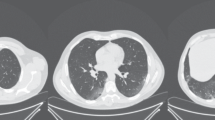Abstract
Lung Segmentation is one of the pre-processing steps for lung cancer diagnosis. Segmentation of lung contour is challenging when the nodules are attached to the surrounding tissues of the lung, such as juxta-pleural boundary or vasculature. This paper proposes a lung parenchyma segmentation framework based on multiple image frames with novel approaches for juxta-pleural nodule identification and lung contour correction. The juxta-pleural nodule identification works by computing the distance between the lung borders on adjacent slices. These approaches extract the lung boundary of current and previous slices and calculate the shortest distance between the two boundary contour points to detect the nodule candidates and correct the nodule boundary. These approaches were experimented on at least 11 thoracic image volumes with juxta-pleural nodules from the LIDC-IDRI dataset and achieved an average volumetric overlap fraction of 98.59%. Compared with the other state-of-the-art methods, the proposed method is simple and very efficient for segmenting the lung parenchyma while including the juxta-pleural nodules.













Similar content being viewed by others
Data Availability
The datasets generated during and/or analysed during the current study are available in the LIDC-IDRI repository, https://wiki.cancerimagingarchive.net/display/ Public/LIDC-IDRI.
Code Availability
The code for the same is hosted at http://github.com/sujijenkin/border2border.
References
Amin J, Sharif M, Yasmin M (2016) Segmentation and classification of lung cancer: a review. Immunol Endoc Metabol Agents Med Chemist (Formerly Current Med Chemist-Immunol Endoc Metabolic Agents) 16(2):82–99
Armato III, Samuel G, McLennan G, Bidaut L, McNitt-Gray MF, Meyer CR, Reeves AP, Zhao B, Aberle DR, Henschke CI, Hoffman EA et al (2011) The lung image database consortium (lidc) and image database resource initiative (idri): a completed reference database of lung nodules on ct scans. Medical Phys 38(2):915–931
Armato III, Samuel G, Nsakovic WF (2004) Automated lung segmentation for thoracic ct: impact on computer-aided diagnosis1. Acad Radiology 11 (9):1011–1021
Chung H, Ko H, Jeon SJ, Yoon KH, Lee J (2018) Automatic lung segmentation with juxta-pleural nodule identification using active contour model and bayesian approach. IEEE J Trans Eng Health Med 6:1–13
Javaid M, Javid M, Rehman MZU, Shah SIA (2016) A novel approach to cad system for the detection of lung nodules in ct images. Comput Methods Prog Biomed 135:125–139
Liu C, Pang M (2020) Automatic lung segmentation based on image decomposition and wavelet transform. Biomed Signal Process Control 61:102032
Mukhopadhyay S (2016) A segmentation framework of pulmonary nodules in lung ct images. J Digital Imaging 29(1):86–103
Nurfauzi R, Nugroho HA, Ardiyanto I (2017) Lung detection using adaptive border correction. In: 2017 3rd International conference on science and technology-computer (ICST). IEEE, pp 57–60
Nurfauzi R, Nugroho H, Ardiyanto I, Frannita E (2021) Autocorrection of lung boundary on 3d ct lung cancer images. J King Saud University-Comput Inf Sci 33(5):518–527
Pu J, Roos J, Chin AY, Napel S, Rubin GD, Paik DS (2008) Adaptive border marching algorithm: automatic lung segmentation on chest ct images. Comput Med Imaging Graph 32(6):452–462
Rachmawati E, Khodra ML, Supriana I (2016) Shape based recognition using freeman chain code and modified needleman-wunsch. In: 2016 8th International conference on information technology and electrical engineering (ICITEE). IEEE, pp 1–6
Sahu P, Zhao Y, Bhatia P, Bogoni L, Jerebko A, Qin H (2020) Structure correction for robust volume segmentation in presence of tumors. IEEE J Biomed Health Inf 25(4):1151–1162
Shen S, Bui AA, Cong J, Hsu W (2015) An automated lung segmentation approach using bidirectional chain codes to improve nodule detection accuracy. Comput Biol Med 57:139–149
Singadkar G, Mahajan A, Thakur M, Talbar S (2021) Automatic lung segmentation for the inclusion of juxtapleural nodules and pulmonary vessels using curvature based border correction. J King Saud Univ-Comp Inf Sci 33 (8):975–987
Van Rikxoort EM, de Hoop B, Viergever MA, Prokop M, van Ginneken B (2009) Automatic lung segmentation from thoracic computed tomography scans using a hybrid approach with error detection. Med Phys 36(7):2934–2947
Wei Y, Shen G, Li JJ (2013) A fully automatic method for lung parenchyma segmentation and repairing. J Digital Imaging 26(3):483–495
Xiao X, Zhao J, Qiang Y, Wang H, Xiao Y, Zhang X, Zhang Y (2018) An automated segmentation method for lung parenchyma image sequences based on fractal geometry and convex hull algorithm. Appl Sci 8(5):832
Zhou S, Cheng Y, Tamura S (2014) Automated lung segmentation and smoothing techniques for inclusion of juxtapleural nodules and pulmonary vessels on chest ct images. Biomed Signal Process Control 13:62–70
Acknowledgements
The authors would like to acknowledge the Kiran Division, Department of Science and Technology, Govt. of India, for funding this research work through the SR/WOSA/ET-153/2017 Research Grant. The authors also thank the anonymous reviewers for their encouraging reviews and recommendations.
Author information
Authors and Affiliations
Corresponding author
Ethics declarations
Conflict of Interests
All the authors declare that he/she has no conflict of interest.
Additional information
Publisher’s note
Springer Nature remains neutral with regard to jurisdictional claims in published maps and institutional affiliations.
Rights and permissions
Springer Nature or its licensor holds exclusive rights to this article under a publishing agreement with the author(s) or other rightsholder(s); author self-archiving of the accepted manuscript version of this article is solely governed by the terms of such publishing agreement and applicable law.
About this article
Cite this article
Suji, R.J., Godfrey, W.W. & Dhar, J. Border to border distance based lung parenchyma segmentation including juxta-pleural nodules. Multimed Tools Appl 82, 10421–10443 (2023). https://doi.org/10.1007/s11042-022-13660-y
Received:
Revised:
Accepted:
Published:
Issue Date:
DOI: https://doi.org/10.1007/s11042-022-13660-y




